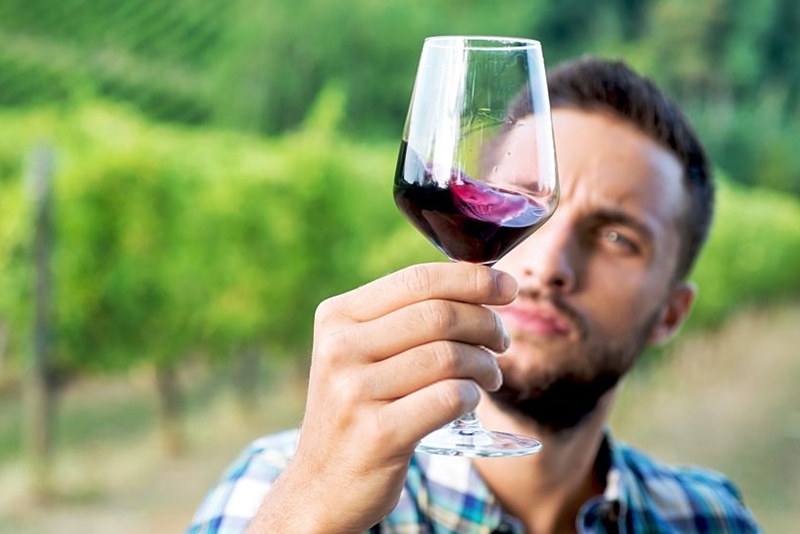Understanding red wine's color spectrum
The intricate dynamics of anthocyanins in red wine

In the world of viticulture and enology, few elements are as crucial and intriguing as the molecules responsible for giving wine its character. Among these, anthocyanins hold a special place. Found predominantly in the skins of grapes, anthocyanins play a pivotal role during the fermentation process, especially in the production of red wine. Their importance lies not just in their presence, but in their ability to react and evolve, resulting in wines of varying hues and tones.
1. Understanding Anthocyanins: The Backbone of Red Wine's Color
Anthocyanins are a type of phenolic compound, primarily responsible for imparting color to red wine. During fermentation, as grape skins macerate in the must (unfermented grape juice), anthocyanins are released. Although they carry other properties, their chief role is in determining the wine's hue. Depending on various external factors, such as pH, sulfites, reduction processes, temperature, and aging time, anthocyanins can manifest in multiple forms, influencing wine's shade.
2. The Impact of pH on Wine's Hue
pH, a measure of acidity, plays a crucial role in defining a wine's color profile. Depending on the pH level:
- Wines with pH values up to 3.5 exhibit a lively red hue.
- Those with pH values ranging from 3.5 to 7.0 tend to have red-purple-blue shades.
- Wines with pH values exceeding 7.0 lean towards a yellow hue.
However, it's essential to note that while anthocyanins contribute to the wine's color, they aren't the sole determinants. In red wines with pH levels between 3.5 and 4.1, only 20-30% of anthocyanins are responsible for the color, with the rest existing in non-colored forms. Furthermore, aged wines exhibit reduced color sensitivity to pH variations.
3. Bottle Aging and Color Dynamics
The aging process in a bottle can lead to color loss in wine. When wine undergoes oxidation, it causes reactions in the anthocyanins. In reductive conditions (lack of oxygen), some anthocyanins can turn colorless, particularly evident in newly fermented wines. However, over extended periods, especially during oxidative aging in bottles, this color attenuation intensifies, albeit more gradually.
4. The Temperature Factor
High temperatures can also influence anthocyanins, turning them yellow. Therefore, during wine aging, it's advisable to maintain a steady and reduced temperature, ideally between 12°C and 15°C.
5. The Barrel Aging Paradox
During barrel aging, a unique equilibrium situation arises. While oxidation can turn anthocyanins into colorless phenolic acids, destroying the wine's hue, the presence of other compounds can counteract this effect. Oxygen, in the presence of certain substances, can enhance and stabilize anthocyanins, preserving their color. For instance, specific anthocyanins can form color complexes with metals, such as iron, copper, and magnesium, resulting in blue-green hues. This reaction is also typical with other polyphenols like tannins.

6. The Sulphite Effect
Sulphites, specifically sulfurous anhydride, can significantly decolorize anthocyanins. This reversible reaction often becomes apparent during wine bottling, where a considerable addition of sulfurous anhydride ensures bottle stability but diminishes color vibrancy. Over time, as the sulfurous component decomposes, the wine can regain its original hue and intensity.
7. Polyphenols and Their Impact
Anthocyanins can also interact with other phenolic compounds, altering wine color in a process called coopigmentation. This results in an increased color intensity, known as the "hyperchromic effect", and a shift towards purple-blue shades, called the "bathochromic effect". Such interactions often manifest in young wines, where reduced oxygen conditions foster the formation of coopigments, contributing to up to 40% of the wine's color intensity.
8. The Role of Fermentation
During or even before fermentation, anthocyanins can combine with yeasts, leading to the formation of stable and initially colorless compounds. However, these compounds can develop orange hues upon oxidation or due to reactions with alcohol and certain sugar breakdown products.
Anthocyanins, with their intricate behaviors and reactions, significantly shape the world of red wines. Their interplay with various factors, both intrinsic and extrinsic, ensures that the journey from grape to glass is one of constant evolution, revealing the art and science behind every bottle.
Founded in 2007, Vinetur® is a registered trademark of VGSC S.L. with a long history in the wine industry.
VGSC, S.L. with VAT number B70255591 is a spanish company legally registered in the Commercial Register of the city of Santiago de Compostela, with registration number: Bulletin 181, Reference 356049 in Volume 13, Page 107, Section 6, Sheet 45028, Entry 2.
Email: [email protected]
Headquarters and offices located in Vilagarcia de Arousa, Spain.